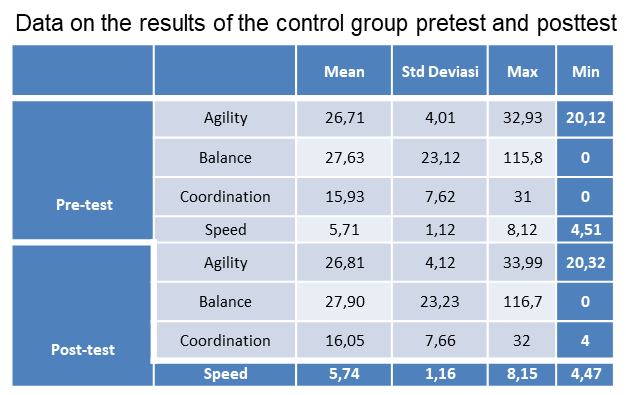Application of Traditional Games: How Does It Affect the Children's Fundamental Motor Skills?
Abstract
This study aims to determine the effect of implementing traditional game learning models on improving basic motor skills in children. The research method used is the experimental method. The designs used are the Pre-test and Post-test Group Design. The study population consisted of two classes with a total of 60 students and the sampling technique used simple random sampling with a sample size of 30 students. The test instruments used in this study included: 1) 4 x 10-meter shuttle run test, 2) throw-and-catch test at a distance of 1 meter from the wall, 3) Stork stand test positional balance, 4.) Test 30 sprint meter. The data analysis technique used is the prerequisite test which includes data normality test and data homogeneity test, as well as hypothesis testing using paired t-test. The results showed that there was an effect of traditional game-based learning models on the improvement of children's Fundamental Motor Skills as evidenced by p-value = 0.001. In addition, from the control group data, it is known that there is no significant effect of conventional learning on improving children's Fundamental Motor Skills as evidenced by p-value = 0.072, with these results it can be concluded that traditional game-based learning models are proven to improve children's fundamental motor skills, and can be used as an alternative to the learning process that is more effective than conventional learning.
Downloads
References
Abbott, A., Collins, D., Martindale, R., & Sowerby, K. (2002). Talent Identification and Development : An Academic Review A report for sportscotland by The University of Edinburgh. Sport Scotland, August, 1–103.
Akbar, R. M. (2013). Pengaruh Olahraga Tradisional Bebentengan Terhadap Kemampuan Motorik (Motor Ability) Anak Usia 6-8 Tahun Universitas Pendidikan Indonesia | repository.upi.edu | perpustakaan.upi.edu. Universitas Pendidikan Indonesia.
Astorino, T. A., Edmunds, R. M., Clark, A., King, L., Gallant, R. A., Namm, S., Fischer, A., & Wood, K. M. (2017). High-Intensity Interval Training Increases Cardiac Output and V-O2max. Medicine and Science in Sports and Exercise, 49(2), 265–273. https://doi.org/10.1249/MSS.0000000000001099
Batacan, R. B., Duncan, M. J., Dalbo, V. J., Tucker, P. S., & Fenning, A. S. (2017). Effects of high-intensity interval training on cardiometabolic health: A systematic review and meta-analysis of intervention studies. British Journal of Sports Medicine, 51(6), 494–503. https://doi.org/10.1136/bjsports-2015-095841
Cattuzzo, M. T., dos Santos Henrique, R., Ré, A. H. N., de Oliveira, I. S., Melo, B. M., de Sousa Moura, M., de Araújo, R. C., & Stodden, D. (2016). Motor competence and health related physical fitness in youth: A systematic review. Journal of Science and Medicine in Sport, 19(2), 123–129. https://doi.org/10.1016/j.jsams.2014.12.004
Festiawan, R., & Arovah, N. I. (2020). Pengembangan “ Buku Saku Pintar Gizi ” Untuk Siswa : Alternatif Media Pembelajaran untuk Meningkatkan Pengetahuan Gizi Olahraga. Physical Activity Journal, 2(1), 188–201. https://doi.org/https://doi.org/10.32424/1.paju.2020.1.2.2436 Abstrak
Festiawan, R., Ngadiman, N., Kusuma, I. J., Nurcahyo, P. J., & Kusnandar, K. (2019). Pengembangan Model Pembelajaran Pendidikan Jasmani Berbasis Games, Education, and Visualisation (GEV) Untuk Meningkatkan Pengetahuan Kesehatan Reproduksi Remaja. Jendela Olahraga, 4(2), 13–25. https://doi.org/10.26877/jo.v4i2.3678
Freitas, D. L., Lausen, B., Maia, J. A., Gouveia, R., Antunes, A. M., Thomis, M., Lefevre, J., & Malina, R. M. (2018). Skeletal maturation, fundamental motor skills, and motor performance in preschool children. Scandinavian Journal of Medicine and Science in Sports, 28(11), 2358–2368. https://doi.org/10.1111/sms.13233
Kamaludin, Ngadiman, Festiawan, R., Kusuma, I. J., & Febriani, A. R. (2020). Pengembangan Permainan Pecah Piring Sintren : Pemanfaatan Olahraga Tradisional Pada Pembelajaran untuk Meningkatkan Kemampuan Motorik Kasar Anak. TEGAR: Journal of Teaching Physical Education in Elementary SchoolJournal of Teaching Physical Education in Elementary School, 3(5), 37–45.
O' Brien, W., Belton, S., & Issartel, J. (2016). Fundamental movement skill proficiency amongst adolescent youth. Physical Education and Sport Pedagogy, 21(6), 557–571. https://doi.org/10.1080/17408989.2015.1017451
Priklerová, S., & Kucharik, I. (2015). Efficiency Of Technical And Tactical Approach To Teaching Minihandball Game Skills In Different Age Categories. Acta Facultatis Educationis Physicae Universitatis Comenianae, 55(2), 132–140. https://doi.org/10.1515/afepuc-2015-0014
Puspitasari, R. N. (2016). Pengaruh permainan tradisional karetan terhadap pembelajaran motorik kasar atletik lompat jauh. Jurnal PG, 3(1), 9–18.
Rusmawati, I. (2016). Penerapan Permainan Tradisional Terhadap Gerak Dasar Motorik Siswa Dalam Pembelajaran Pendidikan Jasmani , Olahraga Dan Kesehatan Pada Siswa Kelas V SDN Margomulyo 1 Bojonegoro. Jurnal Pendidikan Olahraga Dan Kesehatan, 4(2), 435–440.
Vlahov, E., Baghurst, T. M., & Mwavita, M. (2014). Preschool motor development predicting high school health-related physical fitness: A prospective study. Perceptual and Motor Skills, 119(1), 279–291. https://doi.org/10.2466/10.25.PMS.119c16z8
Webster, E. K., & Ulrich, D. A. (2017). Evaluation of the psychometric properties of the Test of Gross Motor Development-third edition. Journal of Motor Learning and Development, 5(1), 45–58. https://doi.org/10.1123/jmld.2016-0003
Wen, D., Utesch, T., Wu, J., Robertson, S., Liu, J., & Hu, G. (2019). Effects of different protocols of high-intensity interval training for VO2max improvements in adults: A meta-analysis of randomized controlled trials. Journal of Science and Medicine in Sport, 1–7. https://doi.org/10.1016/j.jsams.2019.01.013




